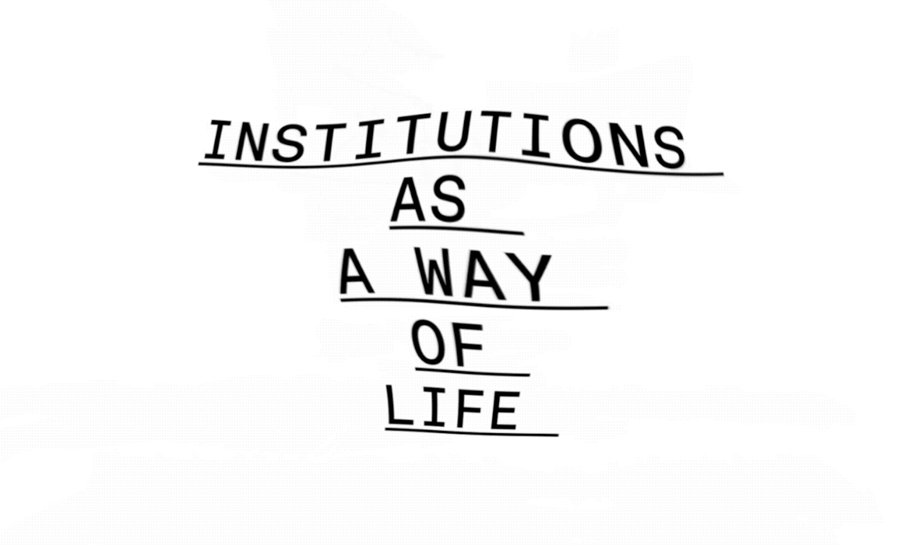Annotating Decentralisation & Graphic Design

If Institutions are assumed as concepts and places of consensus, allowing individuals and communities to govern resources and structure ways of life, then a planetary and distributed perspective on technologies brings forth a difference in how we understand and participate in institutions and their formation, effectively reshaping the concept of Institutions itself. Yet among the current emergence of distributive and ubiquitous technologies that transform the ways of life thus far enabled by classical Institutions, we can trace the histories of how particular practices have been transformed through archaic or anachronistic modes of power distribution.
Graphic Design, as an example, is an institutionally concretised practice, which assumes power by defining and teaching styles, norms and rules. Annotating Decentralisation & Graphic Design focuses on sources whose close reading allows us to reflect the current shift introduced by practices and technologies that attempt to decentralise institutional governance, while reflecting on how styles and practices are governed by institutions. As a special contribution, artist and researcher Luiza Crosman will talk about the notion of scale in relation to the narratives around artistic practices and distributed narratives.
Aiwen Yin and Genevieve Costello have prepared a project reader around the notion of Decentralisation, which distills her research conducted around ReUnion Network, a social initiative that investigates the possibilities to organize different social units by sets of long-term caring relationships, through the lens of blockchain technology. Reunion dives into the actual needs of our contemporary life with the axes of emotional labor, care and balance in everyday relations and encounters, and proposes economic and legal support for openness and solidarity to resist the coming social crisis where the aging society, gig economy and social atomization converged. With ReUnion, the artists explore the alternative social structures that are beyond the nuclear family framework, transforming the imposed legal-institution, such as family and marriage, into bottom-up organizational forms. Through radical reimagination of the interfacial, economic and legal layer of the society, the artists foreground the value of care in the face of the aging society and mass automation, and propose a future where interpersonal relationship is the key social infrastructure for solidarity.
Sonia Malpesos’ work is on a reader that posits Graphic Design itself as an institution, beyond its individual practice organisations and historical institutions. Through this lens, we explore different moments and movements that form part of design practices: ideation, creation, practice, product. How do schools of graphic design – the Swiss school, the slick school – emerge? How do designers’ physical presence in institutions condition and modulate the graphic design process? How does Graphic Design institute its schools of style and laws of form? The Reader is, in itself, a visual reflection on the process of designing an identity for the Institutions as a Way of Life project, for which a “liquid visual identity” was developed that doesn’t consent to being a single modernist thing. At the same time, it is a designers reflection on the institution of graphic design as she experiences it, and how that experience might be manifested in visual concepts and structures of information. Through this reader, the designer attempts to render palpable the sometimes visible, other times invisible grids of composition and character that reshape the concept of graphic design.
In her work on the main stages and in the niches of the contemporary art’s planetary megastructure, Luiza Crosman is investigating operations on how to build collective subjects which could allow for new strategies on tackling institutional resources and its infrastructures. Her work builds upon creating distributed narratives: tramas – a Portuguese word meaning at the same time weave and plot. In her presentation of recent work, she will untangle the crucial question of scale in late-stage capitalist art industry: How do artists that work with institutions can negotiate their subjectivity in order to deal with, resist or propose scaling effects into the world? How can artworks and practices acquire scale through technology? How can the institution’s appeal of faux grandeur be resisted or appropriated while using their infrastructures to acquire reach and resonance?
With Aiwen Yin, Genevieve Costello, Luiza Crosman, Sonia Malpeso, Mela Dávila Freire, Jamie Allen, Lucie Kolb, Bernhard Garnicnig
October 1, 10-18.00
Critical Media Lab (D. 3.05)
No formal registration is required, but we appreciate a quick and informal email to let us know you are coming to mail@institutions.life
Workshop & Discussion Series




